tow BUICK REGAL 1995 Owners Manual
[x] Cancel search | Manufacturer: BUICK, Model Year: 1995, Model line: REGAL, Model: BUICK REGAL 1995Pages: 340, PDF Size: 17.16 MB
Page 17 of 340
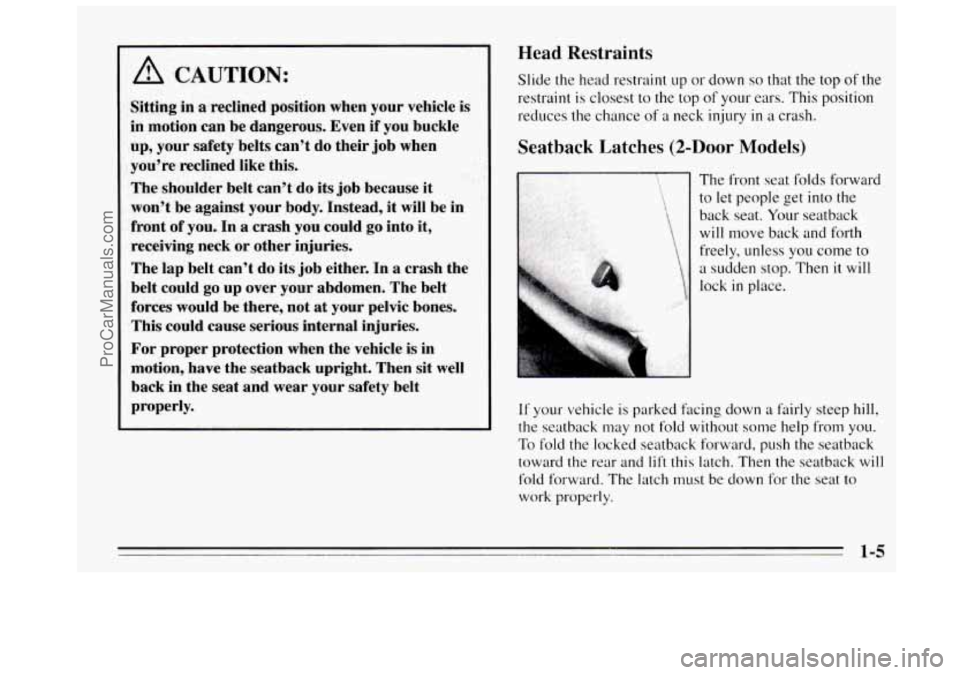
Head Restraints
Slide the head restraint up or down so that the top of the
restraint
is closest to the top of your ears. This position
reduces the chance
of a neck injury in a crash.
Seatback Latches (2-Door Models)
lr your vehicle is parked facing down a Fairly steep hill,
the seatback may not fold without some help from you.
To fold the locked seatback forward, push the seatback
toward the rear and
lift this latch. Then the seatback will
fold forward. The latch must be down for the seat to
work properly.
1-5
ProCarManuals.com
Page 34 of 340
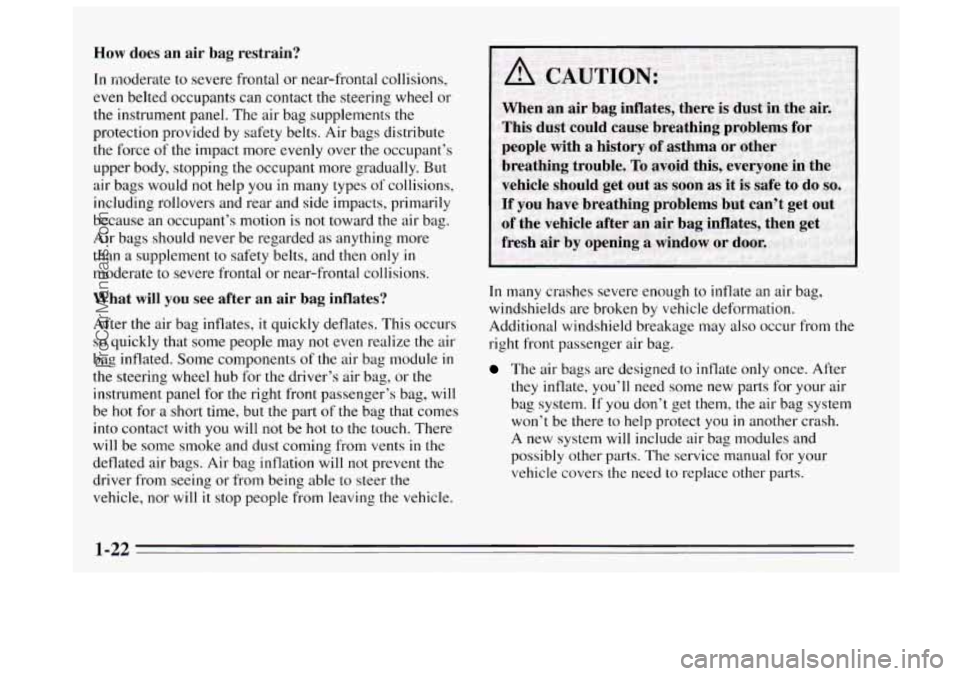
How does an air bag restrain?
In moderate to severe frontal or near-frontal collisions,
even belted occupants
can contact the steering wheel or
the instrument panel. The air bag supplements
the
protection provided by safety belts. Air bags distribute
the force of the impact more evenly over the occupant’s
upper body, stopping the occupant more gradually. But
air bags would not help you in many types of collisions,
including rollovers and rear and side impacts, primarily
because an occupant’s motion is not toward the air bag.
Air bags should never be regarded as anything more
than
a supplement to safety belts, and then only in
moderate to severe frontal or near-frontal collisions.
What will you see after an air bag inflates?
After the air bag inflates, it quickly deflates. This occurs
so quickly that some people may not even realize the air
bag inflated. Some components of the air bag module
in
the steering wheel hub for the driver’s air bag, or the
instrument panel for the right front passenger’s bag, will
be
hot for a short time, but the part of the bag that comes
into contact with you
will not be hot to the touch. There
will be some smoke and dust coming from vents
in the
deflated air bags. Air bag inflation will not prevent the
driver from seeing or from being able to steer the
vehicle, nor will
it stop people from leaving the vehicle. In
many crashes severe enough to inflate an air bag,
windshields are broken by vehicle deformation.
Additional windshield breakage may
also occur from the
right front passenger air bag.
The air bags are designed to inflate only once. After
they inflate,
you’ll need some new parts for your air
bag system.
If you don’t get them, the air bag system
won’t be there to help protect you
in another crash.
A
new system will include air bag modules and
possibly other parts. The service manual for your
vehicle covers the need to replace other parts.
1-22
-- -
ProCarManuals.com
Page 60 of 340
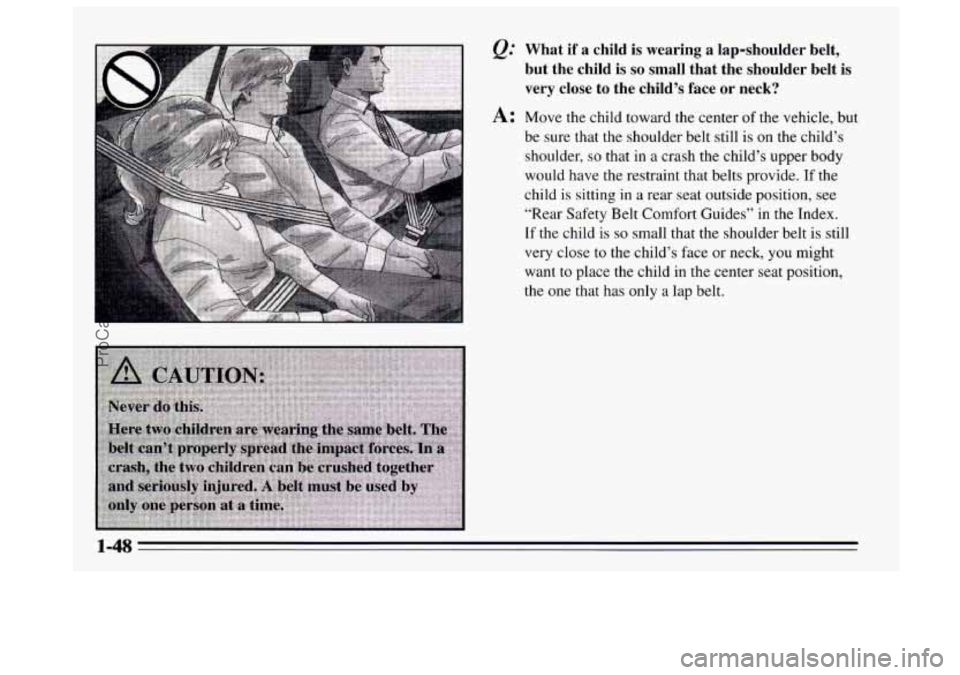
&= What if a child is wearing a lap-shoulder belt,
but the child is
so small that the shoulder belt is
very close to the child’s face or neck?
A: Move the child toward the center of the vehicle, but
be sure that
the shoulder belt still is on the child’s
shoulder,
so that in a crash the child’s upper body
would have the restraint that belts provide.
If the
child is sitting
in a rear seat outside position, see
“Rear Safety Belt Comfort Guides” in the Index.
If the child is so small that the shoulder belt is still
very close to the child’s face or neck, you might
want to place the child
in the center seat position,
the one that has only a lap belt.
1-48
ProCarManuals.com
Page 72 of 340
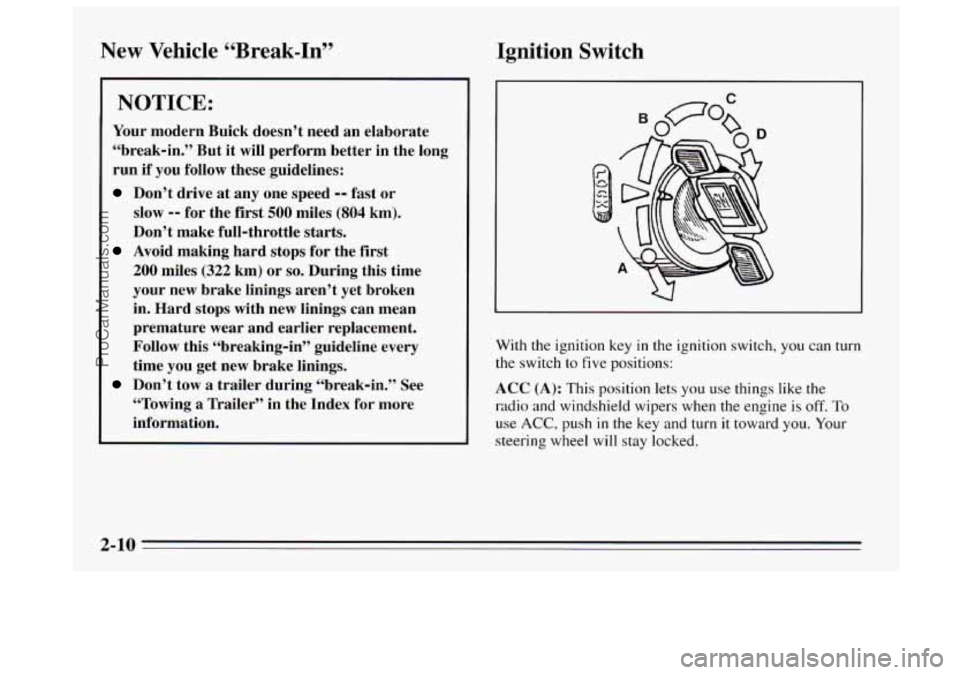
New Vehicle “Break-In”
NOTICE:
Your modern Buick doesn’t need an elaborate
“break-in.” But it will perform better in the long
run if you follow these guidelines:
Don’t drive at any one speed -- fast or
slow
-- for the first 500 miles (804 km).
Don’t make full-throttle starts.
200 miles (322 km) or so. During this time
your new brake linings aren’t yet broken
in. Hard stops with new linings can mean
premature wear and earlier replacement.
Follow this “breaking-in” guideline every
time you get new brake linings.
Don’t tow a trailer during “break-in.” See
“Towing a Trailer’’ in the Index for more
information.
Avoid making hard stops for the first
Ignition Switch
U
With the ignition key in the ignition switch, you can turn
the switch
to five positions:
ACC (A): This position lets you use things like the
radio and windshield wipers when the engine is
off. To
use ACC, push in the key and turn it toward you. Your
steering wheel will stay locked.
2-10
ProCarManuals.com
Page 73 of 340
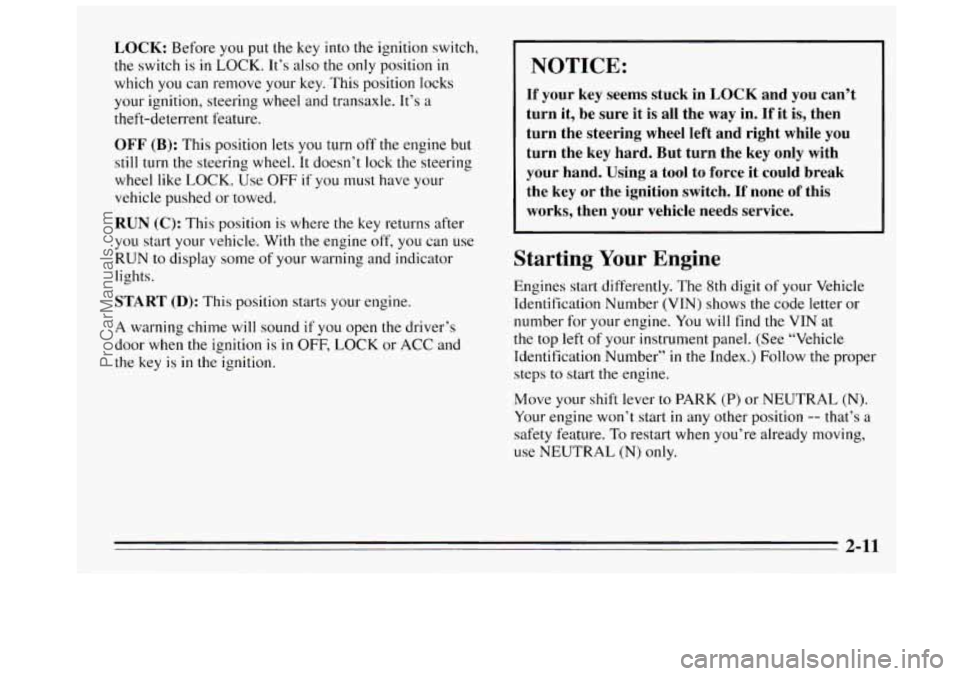
LOCK: Before you put the key into the ignition switch,
the switch is in
LOCK. It’s also the only position in
which you can remove your key. This position locks
your ignition, steering wheel and transaxle. It’s a
theft-deterrent feature.
OFF (B): This position lets you turn off the engine but
still turn the steering wheel. It doesn’t lock the steering
wheel
like LOCK. Use OFF if you must have your
vehicle pushed or towed.
RUN (C): This position is where the key returns after
you start your vehicle. With the engine off,
you can use
RUN to display some
of your warning and indicator
lights.
START (D): This position starts your engine.
A warning chime will sound if you open the driver’s
door when
the ignition is in OFF, LOCK or ACC and
the key is
in the ignition.
NOTICE:
If your key seems stuck in LOCK and you can’t
turn it, be sure it is all the
way in. If it is, then
turn the steering wheel left and right while you
turn the key hard. But turn the key only with
your hand. Using a tool to force it could break
the key or the ignition switch. If none of this
works, then your vehicle needs service.
Starting Your Engine
Engines start differently. The 8th digit of your Vehicle
Identification Number (VIN) shows the code letter
or
number for your engine. You will find the VIN at
the top
left of your instrument panel. (See “Vehicle
Identification Number” in
the Index.) Follow the proper
steps to start
the engine.
Move your shift lever
to PARK (P) or NEUTRAL (N).
Your engine won’t start
in any other position -- that’s a
safety feature. To restart when you’re already moving,
use NEUTRAL
(N) only.
2-11
ProCarManuals.com
Page 74 of 340
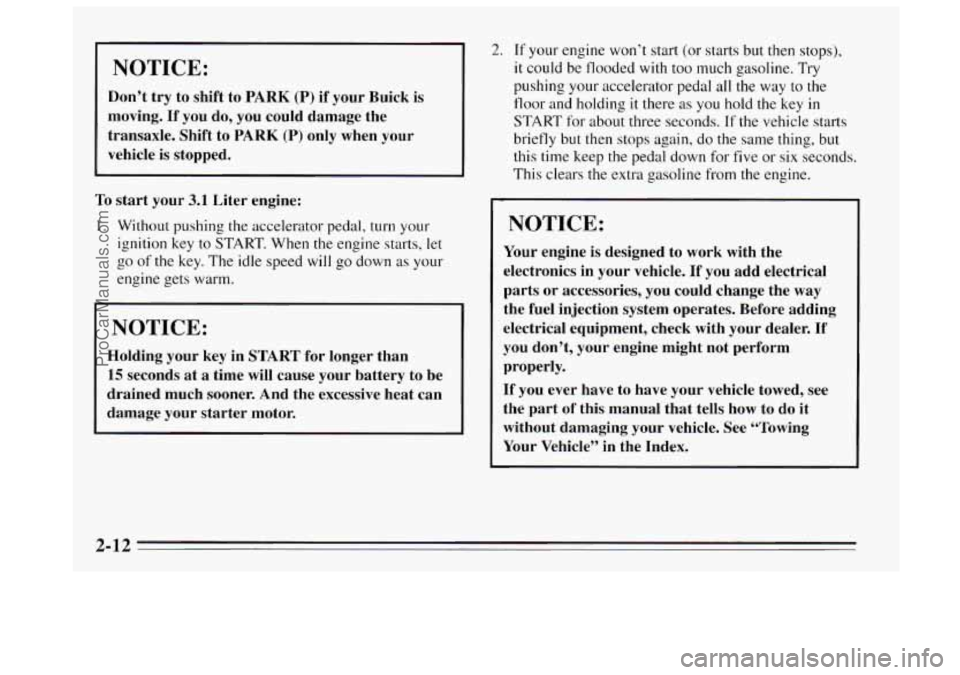
NOTICE:
Don’t try to shift to PARK (P) if your Buick is
moving.
If you do, you could damage the
transaxle. Shift to
PARK (P) only when your
vehicle is stopped.
To start your 3.1 Liter engine:
1. Without pushing the accelerator pedal, turn your
ignition key to START. When
the engine starts, let
go of the key. The idle speed will go down as your
engine gets warm.
NOTICE:
Holding your key in START for longer man
15 seconds at a time will cause your battery to be
drained much sooner. And the excessive heat can
damage your starter motor.
2. If your engine won’t start (or starts but then stops),
it could be flooded with too much gasoline. Try
pushing your accelerator pedal all the way
to the
floor and holding it there as you hold the key in
START for about three seconds. If the vehicle starts
briefly but t.hen stops again, do the same thing, but
this time keep the pedal down for
five or six seconds.
This clears the extra gasoline
from the engine.
~
NOTICE:
Your engine is designed to work with the
electronics in
your vehicle. If you add electrical
parts
or accessories, you could change the way
the fuel injection system operates. Before adding
electrical equipment, check with your dealer.
If
you don’t, your engine might not perform
properly.
If you ever have to have your vehicle towed, see
the part
of this manual that tells how to do it
without damaging your vehicle. See “Towing
Your Vehicle” in the Index.
2-12
ProCarManuals.com
Page 75 of 340
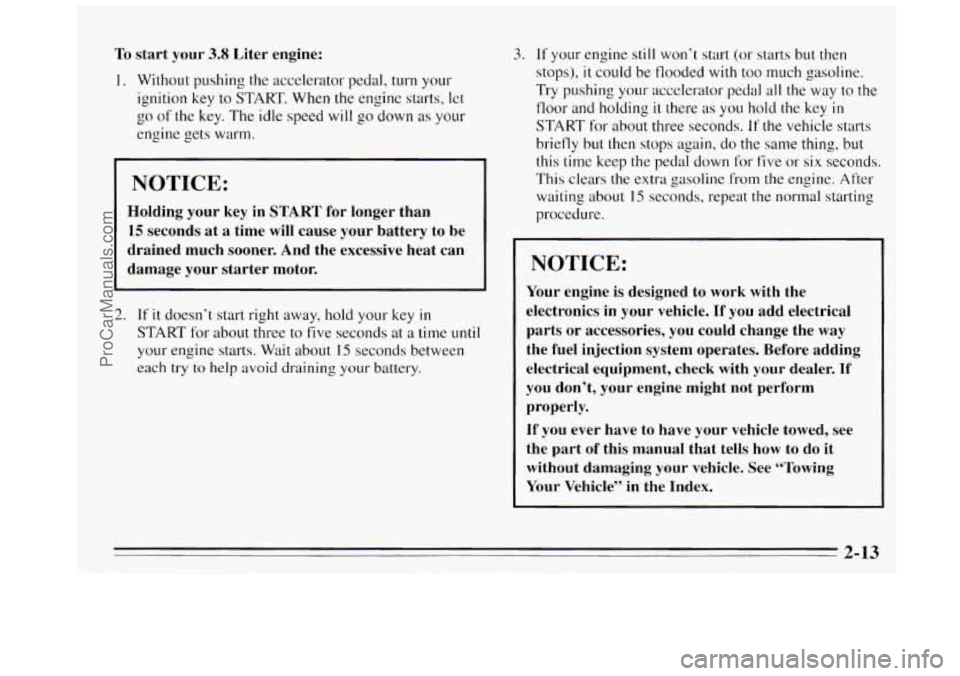
To start your 3.8 Liter engine:
I. Without pushing the accelerator pedal, turn your
ignition
key to START. When the engine starts, let
go
of the key. The idle speed will go down as your
engine gets warm.
I NOTICE:
Holding your key in START for longer than
15 seconds at a time will cause your battery to be
drained much sooner. And the excessive heat can
damage your starter motor.
2. If it doesn’t start right away, hold your key in
START for about three to five seconds at a time until
your engine starts. Wait about
15 seconds between
each try
to help avoid draining your battery.
3. If your engine still won’t start (or starts but then
stops), it could be flooded with too much gasoline.
Try pushing your accelerator pedal
all the way to the
floor and holding
it there as you hold the key in
START for about three seconds. If the vehicle starts
brietly but then stops again, do the
same thing, but
this time keep the pedal down for
five or six seconds.
This clears the extra gasoline from the engine. After
waiting about 15 seconds, repeat the normal starting
procedure.
NOTICE:
Your engine is designed to work with the
electronics in your vehicle.
If you add electrical
parts or accessories, you could change the way
the fuel injection system operates. Before adding
electrical equipment, check with
your dealer. If
you don’t, your engine might not perform
properly.
If you ever have to have your vehicle towed, see
the part of this manual that tells how to do it
without damaging your vehicle. See “Towing
Your Vehicle” in the Index.
2-13
ProCarManuals.com
Page 78 of 340
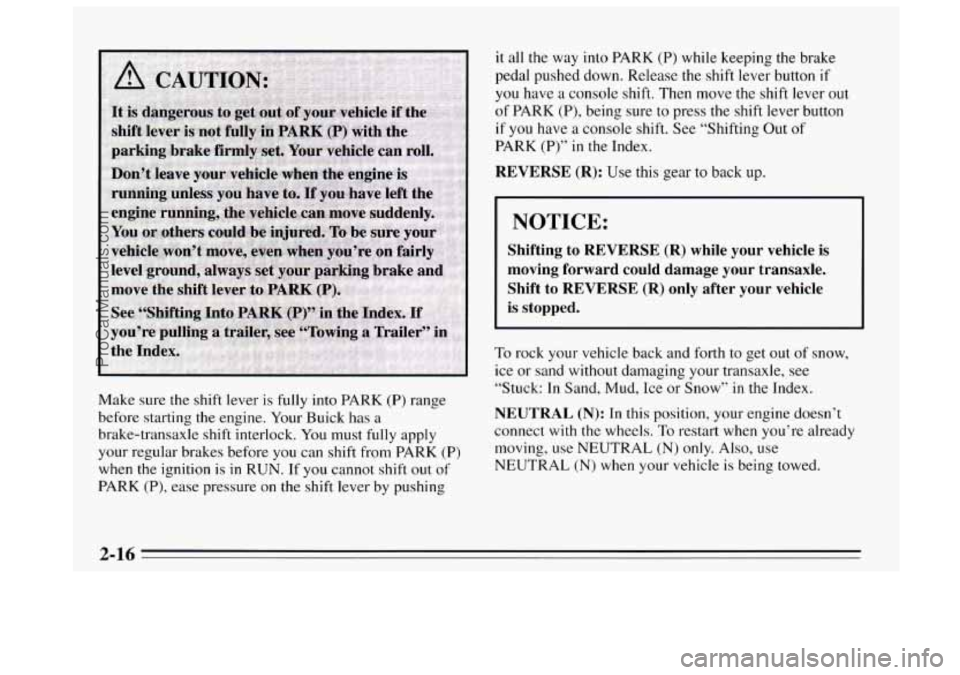
Make sure the shift lever is fully into PARK (P) range
before starting the engine. Your Buick has a
brake-transaxle shift interlock. You must fully apply
your regular brakes before you can shift from
PARK (P)
when the ignition is in RUN. If you cannot shift out of
PARK
(P), ease pressure on the shift lever by pushing
it all the way into PARK (P) while keeping the brake
pedal pushed down. Release the shift lever button
if
you have a console shift. Then move the shift lever out
of PARK (P), being sure to press the shift lever button
if you have a console shift. See “Shifting Out of
PARK (P)” in the Index.
REVERSE (R): Use this gear to back up.
NOTICE:
Shifting to REVERSE (R) while ybm vehicle is
moving forward could damage your transaxle.
Shift to REVERSE
(R) only after your vehicle
is stopped.
To rock your vehicle back and forth to get out of snow,
ice
or sand without damaging your transaxle, see
“Stuck: In Sand, Mud, Ice or Snow” in the Index.
NEUTRAL (N): In this position, your engine doesn’t
connect with the wheels.
To restart when you’re already
moving, use NEUTRAL (N)
only. Also, use
NEUTRAL (N) when your vehicle is being towed.
ProCarManuals.com
Page 79 of 340

I NOTICE:
Damage to your transaxle caused by shifting out of
PARK (P) or NEUTRAL (N) with the engine
racing isn’t covered by your warranty.
DRIVE (D): This position is for normal driving. It is the
Overdrive position.
If you need more power for passing,
and you’re:
- Going less than 35 mph (56 km/h), push your
accelerator pedal about halfway
down.
- Going about 35 mph (56 km/h) or more, push the
accelerator pedal all
the way down.
You’ll shifi down to the next gear and have more power.
NOTICE:
If your vehicle seems to start up rather slowly, or
if it seems not to shift gears as you go faster,
something may be wrong with
a transaxle system
sensor.
If you drive very far that way, your vehicle
can be damaged.
So, if this happens, have your
vehicle serviced right away. Until then, you can
use
SECOND (2) when you are driving less than
35 mph (56 km/h) and DRIVE (D) for higher speeds.
THIRD (3): THIRD (3) is like DRIVE (D), but you
never go into Overdrive.
Here are some times you might choose
THIRD (3)
instead of DRIVE (D):
- When driving on hilly, winding roads.
- When towing a trailer, so there is less shifting
- When going down a steep hill.
between gears.
2-17
ProCarManuals.com
Page 81 of 340
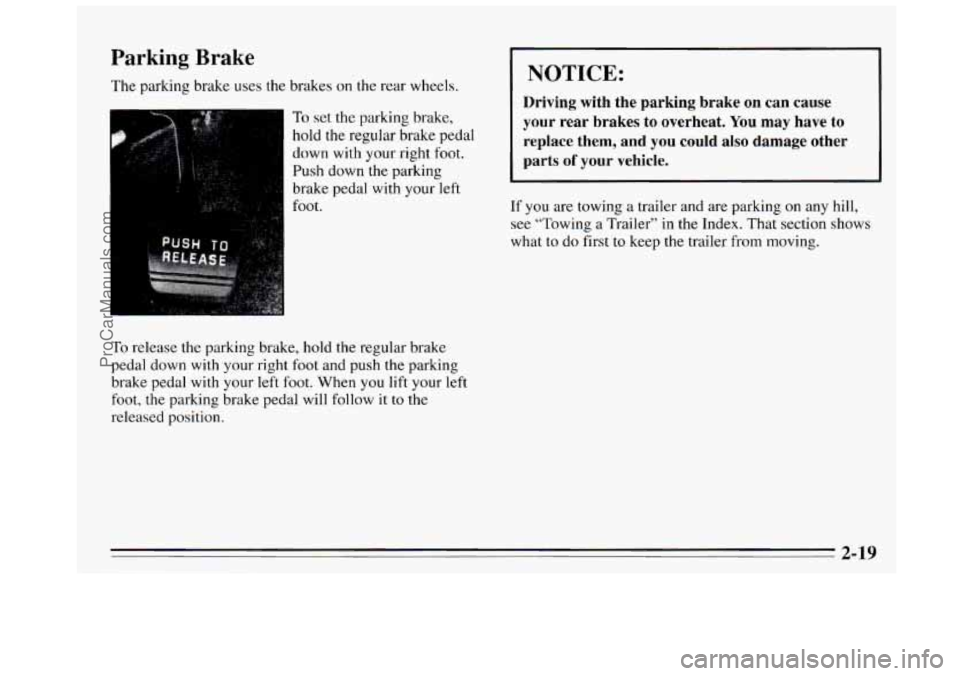
Parking Brake
The parking brake uses the brakes on the rear wheels.
To set the parking brake,
hold the regular brake pedal
down with your right foot.
Push down the parking
brake pedal with your left
To release the parking brake, hold the regular brake
pedal down with your right foot and push the parking
brake pedal with your
left foot. When you lift your left
foot, the parking brake pedal will follow
it to the
released position.
NOTICE:
Driving with the parking brake on can cause
your rear brakes
to overheat. You may have to
replace them, and
you could also damage other
parts
of your vehicle.
If you are towing a trailer and are parking on any hill,
see “Towing a Trailer” in the Index. That section shows
what to do first to keep the trailer from moving.
2-19
ProCarManuals.com